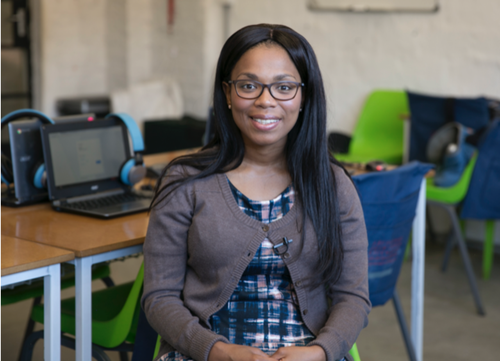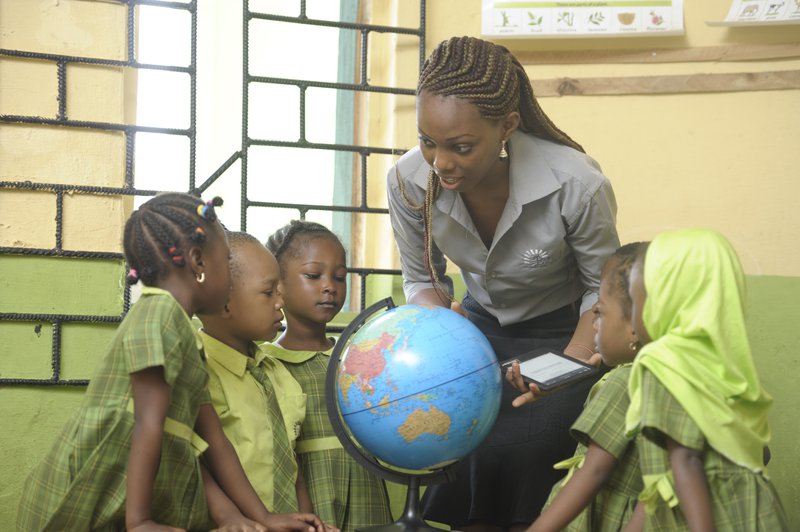The Promise of Equitable Edtech: Debunking Three Common Edtech Myths

Across the US and around the world, education technology, or “edtech,” has been under attack. There are theories that companies are trying to enter classrooms to get children hooked on non-educational products as early as possible, as well as critics who question digital media’s contributions to learning results for all children across the income spectrum and its potential to exacerbate pressing inequities in education.
While some of the critique is fair and should be debated, as education impact investors in emerging and low-income markets, we see the tremendous potential of what we call “Equitable Edtech” — realizing the promise of technology to be a great equalizer in improving quality education for children in need. In fact, when thoughtfully employed, equitable edtech models have the potential to close the learning gap for underserved students by empowering teachers to be even more effective, and by enabling collaborative and student-directed learning. Contrary to many perceptions, edtech can even be used in lower resource settings with low to no bandwidth — and still be impactful and benefit the most disadvantaged students.
We see the tremendous potential of what we call “Equitable Edtech” — realizing the promise of technology to be a great equalizer in improving quality education for children in need.
Let’s debunk three common edtech myths and show you why we are so invested in the promise of equitable edtech.
Myth 1: Edtech is about replacing the teacher in the classroom
For centuries, the teacher has been the arbiter of all things in the classroom. They have been expected to design a lesson plan, deliver relevant content, keep students engaged, and produce learning outcomes, day in and day out. These expectations are particularly challenging to meet in countries like South Africa and Brazil where, sadly, teachers often have not had the opportunity and training to master the content they are expected to be teaching. They also face large, overcrowded classrooms with students that can be as many as three to four years behind grade level.
Geekie, one of the leading edtech businesses in Latin America, is addressing many of these challenges and has been used by more than 10 million students in Brazil, including those lower income learners studying in the challenged Brazilian public school system. Their educational solution, Geekie One, includes a range of digital tools to support teachers in everyday administrative tasks, including testing and homework management that can occupy more than 30 percent of the typical teacher’s day, distracting them from actual teaching. Perhaps most exciting, their Geekie One product will soon include a machine learning platform that gives the teacher frequent and personalized study plans for each student, which is critical to closing the large learning gaps that exist among students in Brazilian classrooms.
“My biggest learning working with Geekie is that our technology is most powerful in the hands of teachers.” — Claudio Sassaki, Geekie
By collecting and analyzing data on student competencies and gaps, edtech platforms like Geekie’s enable teachers to target their instruction more efficiently and effectively. Geekie’s founder and CEO Claudio Sassaki says, “My biggest learning working with Geekie is that our technology is most powerful in the hands of teachers. If we help teachers do their job better, more efficiently, with more information, they are the superheroes that can really improve the quality of education in this country.”
Another example is SPARK Schools, a low-cost independent school network from South Africa that attracts low- and middle-income families. SPARK Schools is finding success through their “blended learning” model that combines traditional classroom teaching with technology to extend the opportunity for their students to practice, inquire, and learn at their own pace. They have been able to deliver this quality education at about $1,500 USD per student per year, the same as what the government spends at public schools.

Deone Billings, the principal at SPARK Maboneng, shared how their blended learning model supports teachers: “In a mainstream classroom, you’re either achieving and moving with the classroom, or you get left behind …. We offer personalized learning. We know where our scholars are, and we know where the gaps are and daily we are supporting scholars to address those gaps.”
Myth 2: Edtech is isolating children and has limited educational value
We have come a long way since the highly criticized “One Laptop per Child” that helped shape perceptions about students sitting alone, watching screens with limited educational content. While digital media has progressed since then, concerns linger that technology promotes isolation and has limited educational value.
True, technology in the classroom means students spend a portion of their school day independently working. Thankfully, we are now much better informed by years of research about what makes good pedagogy and sound instruction and that is integrated within the best blended and tech-based learning programs. We know that there is robust evidence regarding project-based learning (PBL) and how collaboration between students on multidisciplinary projects can help improve mastery of content and 21st century competencies. There is now additional evidence that integrating technology to power PBL boosts learning outcomes across income, racial, and ethnic lines.
Akshara Foundation, a nonprofit organization in India that leverages offline and online education solutions for the underserved, is a great example of a project-based learning approach powered by a technology backbone. Akshara’s Ganitha Kalika Andolana (GKA) is a technology-enabled math program targeted to primary school students (grades 1–5) that provides an activity-based curriculum with real-world cases and collaborative learning materials aimed at developing critical math skills required to progress to middle schools. Akshara has already reached more than 1 million children across multiple states in India through partnerships with the local government.
Just because learning materials cannot be delivered through digital devices in our classrooms, does not mean that we do not need technology to enable GKA’s impact.
Ashok Kamath, Akshara
According to Akshara’s founder and chairman, Ashok Kamath, “We could not have scaled the delivery and impact of the GKA math program without the back-end technology system that enables real-time assessment and analysis of classroom data. Just because learning materials cannot be delivered through digital devices in our classrooms, does not mean that we do not need technology to enable GKA’s impact.”
Myth 3: Edtech is reserved for resource-rich classrooms with more affluent students, highly trained teachers, and broadband connectivity
There is a common claim that edtech only works in schools in higher-income locations, with fast broadband internet connections, and highly trained teachers. While such environments certainly present an ideal context for whole school implementation of education technology, lower-income communities with less-prepared teachers and low-to-no connectivity have successfully implemented edtech solutions with significant and positive results.
Akshara, mentioned previously, is proving edtech can be a solution in places with limited connectivity. In the remote classrooms in India where they work, they rely on an SMS-based monitoring and assessment system through which data can be collected offline and later synched and sent for analysis. Larger benchmark assessments are administered through a basic app on a low-cost Android tablet with offline data collection options.
There is also Bridge International Academies, a network of schools in some of the most marginalized communities — living on under $2 USD a day — that uses tech to help them deliver high-quality learning. Currently Bridge has served more than 300,000 students in nursery and primary schools across Kenya, Uganda, Nigeria, Liberia, and India. A key element of their model uses tech to provide teachers with continual professional development support and teaching best practices. Bridge’s e-learning platform delivers lesson plans using teacher guides that can work over 2G (available to 95 percent of the world’s population) that reach all of Bridge’s classrooms and allow for real-time data collection of teacher attendance, lessons delivered, and student performance. No matter how remote the classroom, the tech is delivering results. Students have outperformed their peers in every single national exam they’ve sat.

Another great model is Siyavula, an adaptive technology platform based in South Africa that uses tech to deliver science and math curriculum that directly complements what students are learning in the classroom. Through partnerships with mobile service providers, Siyavula has been able to eliminate data fees which are often a barrier for edtech to reach those underserved. Since their technology is available in both the classroom and on mobile phones, it allows students to work when and how it best meets their needs and schedules, which particularly helps those from low-income communities.
This is a game changer. It will help a lot of students to be more responsible for their own learning.
Elekyniani Matia, Siyavula
Said Elekyniani Matia, a 10th grade math teacher in the Soweto township in South Africa, “When I first heard of it I thought, ‘This is a game changer.’ It will help a lot of students to be more responsible for their own learning. They will actually learn at their own pace …. It’s like they have their own personal tutor.”
Equitable edtech has the potential to improve learning opportunities for children all over the world, including the 4 billion people who live in communities with limited internet connectivity. As edtech investors, while we know we’ll still encounter our critics and challenges, we are driven by SDG4 of ensuring inclusive and quality education for all by 2030. Edtech can be a great equalizer — and with 617 million children and adolescents leaving school without achieving minimum proficiency levels in reading and math, and for those who aren’t learning 21st century competency skills, we need to utilize all of the tools available, including scalable edtech, to reach those most in need.
This piece was adapted from an op-ed that ran in Techonomy on August 23rd. We welcome your feedback.